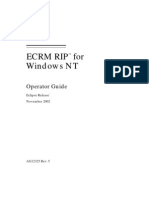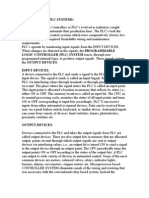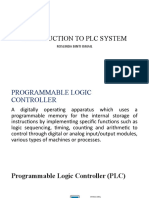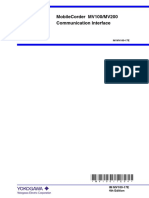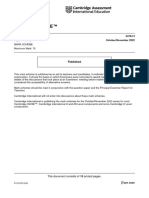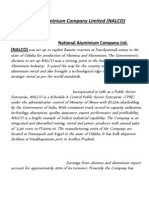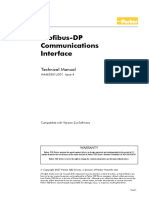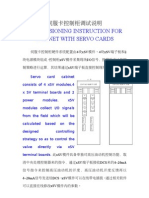Programmable Logic Controller (PLC) and Automation
Programmable Logic Controller (PLC) and Automation
Uploaded by
Jeeva RajCopyright:
Available Formats
Programmable Logic Controller (PLC) and Automation
Programmable Logic Controller (PLC) and Automation
Uploaded by
Jeeva RajOriginal Description:
Original Title
Copyright
Available Formats
Share this document
Did you find this document useful?
Is this content inappropriate?
Copyright:
Available Formats
Programmable Logic Controller (PLC) and Automation
Programmable Logic Controller (PLC) and Automation
Uploaded by
Jeeva RajCopyright:
Available Formats
1
EJ501
PROGRAMMABLE
LOGIC
CONTROLLER (PLC)
AND AUTOMATION
UNIT 3
INTRODUCTION TO PLC SYSTEM
Objective :
1.
Understand basic characteristics of PLC
PLC terminologies
PLC function/ background
Type / advantages of PLC
2.
Understand building structure of PLC
CPU, memory unit, display and indicator unit, input and output interface
3.
Understand PLC hardware unit
Housing unit, programming unit, power supply unit, printer unit
4.
Explain input and output device
UNIT 3
INTRODUCTION TO PLC SYSTEM
Introduction PLC (Programmable Logic Control)
A digital device (microprocessor based controller) that uses a programmable memory
to store instructions and to implement functions such as logic, sequencing, timing,
counting and arithmetic in order to control machines and processes and has been
specifically designed to make programming easy.
PLCs are similar to computers but have certain features which are specific to their use
as controllers:
i.
ii.
iii.
They are rugged and designed to withstand vibrations, temperature, humidity
and noise.
The interfacing for inputs and outputs is inside the controller.
There are easily programmed.
UNIT 3
INTRODUCTION TO PLC SYSTEM
Definition PLC
A digitally operated electronic apparatus which uses a
programmable memory for the internal storage of
instructions for implementing specific functions such as
logic, sequencing, timing, counting, and arithmetic to
control, through digital or analog input/output modules,
various types of machines or processes.
- National Electrical Manufacturers Association
(NEMA)
UNIT 3
INTRODUCTION TO PLC SYSTEM
Definition PLC
An electronic system working digitally for the use in industrial environment
with a programmable memory for the internal storage of user-orientated control
instructions for the implementation of specific functions, like, for example
logic operation control, process control, timer, counting-and arithmetic
functions, in order to control various machines and processes through digital or
analog input- , and output variables.
The logic programmable controls as well as the peripheral installations (PLCsystem) are designed so that they can be easily integrated in an industrial
control system and be implemented in all their desired functions.
- International Standard
IEC 61131-1
UNIT 3
INTRODUCTION TO PLC SYSTEM
PLC Background
The first Programmable Logic Controller (PLC) was developed by a group
of engineers at General Motors in 1968
The company was looking for an alternative to replace complex relay
control systems :
Must be programmable (and reprogrammable)
Designed to operate in an industrial environment
Must accept 120 V ac signals from pushbuttons, switches
Outputs must switch and continuously operate loads such as motors
and relays of two amps rating
Before the 1980s, programmable controllers were called PCs.
UNIT 3
INTRODUCTION TO PLC SYSTEM
PLC Functions
PLC performs the functions of conventional relays, timers,
counters.
Capable of storing instructions, such as sequencing, timing,
counting, arithmetic, data manipulation, and communication,
to control industrial machines and processes.
UNIT 3
INTRODUCTION TO PLC SYSTEM
Type of PLC - compact
TECOMAT
TC600
Omron
Mitsubishi
Zelio
UNIT 3
INTRODUCTION TO PLC SYSTEM
Type of PLC - modular
Omron
Mitsubishi
Eaton
10
UNIT 3
INTRODUCTION TO PLC SYSTEM
Type of PLC plug in card
11
UNIT 3
INTRODUCTION TO PLC SYSTEM
Advantages and Disadvantages of PLC
Advantages
Disadvantages
Many inputs and outputs, excellent for
controlling and monitoring many
processes
Do not use the full capabilities of the
microprocessor
Designed for industrial environments,
robust and reliable
Ladder logic programming style is
cumbersome and prone to mistakes
Reprogrammable
Only good for yes/no decisions
Modular
Do not handle continuous inputs and
outputs, not good for direct control
Ideally suited to supervisory control
Inflexible
(compared
microprocessors)
Easy to set up, good for FMS
environment
to
12
UNIT 3
INTRODUCTION TO PLC SYSTEM
Initial Specifications
The new control system had to be price competitive with the use of relay
systems.
The system had to be capable of sustaining an industrial environment.
The input and output interfaces had to be easily replaceable.
The controller had to be designed in modular form, so that
subassemblies could be removed easily for replacement or repair.
The control system needed the capability to pass data collection to a
central system.
The system had to be reusable.
The method used to program the controller had to be simple, so that it
could be easily understood by plant personnel.
13
UNIT 3
INTRODUCTION TO PLC SYSTEM
Recent PLCs
Changes include both hardware (physical components)
and software (control program) upgrades
Faster scan times are being achieved using new, advanced
microprocessor and electronic technology.
Small, low-cost PLCs (Figure 1), capable of replacing four
to ten relays, now have more power than their predecessor,
the simple relay replacer.
14
UNIT 3
INTRODUCTION TO PLC SYSTEM
A personal computer (PC) is the most commonly used programming device
The software allows users to create, edit, document, store and troubleshoot
programs
The personal computer communications with the PLC processor via a serial or
parallel data communications link
15
UNIT 3
INTRODUCTION TO PLC SYSTEM
Hand-held programming devices are sometimes used to program small PLCs
They are compact, inexpensive, and easy to use, but are not able to display as much
logic on screen as a computer monitor
It is often used on the factory floor for troubleshooting, modifying programs, and
transferring programs to multiple machines
16
UNIT 3
INTRODUCTION TO PLC SYSTEM
Basic PLC Structure
Basic internal structure
of PLC consists
essentially of :
-processing unit (CPU)
-memory
-input/output units
17
UNIT 3
INTRODUCTION TO PLC SYSTEM
Hardware of the PLC
Hardware of the PLC are only
consist of several components;
such as Power Supply Unit,
CPU Unit, Memory Unit and
I/O Unit.
At the small PLC; Power
Supply, CPU, Memory and I/O
stay in the same Unit but at the
big PLC; Power Supply, CPU,
Memory and I/O in the separate
Unit.
18
UNIT 3
INTRODUCTION TO PLC SYSTEM
Power Supply
The Power Supply is used to give power to all the parts. The most PLC works with power
24 VDC or 220 VAC. The big PLC has the separate power supply and the small PLC has
power supply which is one. The Power Supply is also provided by the battery back up,
when happened the failure of power, automatically battery will replace the power supply to
supply the CPU, so that the program of memory user do not lose.
Memory Unit
The Memory Unit has function to save the data and program will be used by PLC. This
Memory is divisible into two type that is ROM and RAM. ROM contains the data like
facility of the logic program, facility to edit the program, facility to monitor the program,
facility for the communications, etc. The Data will be save permanently and will not lose
though the power supply is off. While RAM contains the data of user program, like ladder
diagram, memory data, I/O status, etc. The Data can be writed and read. RAM has the
character is not permanent, if the power suplply is off the data will lose. To avoid the
mentioned, so the power supply is provided by the battery back up to supply if the especial
power supply is off.
19
UNIT 3
INTRODUCTION TO PLC SYSTEM
CPU Unit (Central Processing Unit)
Without seeing to type of PLC ( small, medium,
big) processors and memory always in the same
unit. This unit is referred as the CPU. The CPU
is the brain of a PLC. The CPU is a 8 bit, 16 bit
or 32 bit microcontroller. The CPU has function
to handle communications with the external
apparatus, interconnectivity between the parts
of PLC, executes the program, managements
the memory, observing or perceiving the input
signal and gives the output signal ( as according
to the program or process run). The CPU is also
provided by the indicator lamp as indicator of
the happening of mistake and damage.
20
UNIT 3
INTRODUCTION TO PLC SYSTEM
I/O Unit
The I/O Unit is the interface unit has function to convert the input signal and output
signal so that the CPU can communicate with the external apparatus like the switch,
stepping motor, solenoid, sensor, etc. The I/O Unit has two type; Discrete I/O and
Analog I/O.
21
UNIT 3
INTRODUCTION TO PLC SYSTEM
Omron PLC
LG PLC
22
UNIT 3
INTRODUCTION TO PLC SYSTEM
Input Devices
PLCs can receive input from either automated or manual devices. The PLC
could receive data from the user via a pushbutton switch, keyboard, or similar
device. Automated input could come from a variety of devices: microswitches,
timers, encoders, photosensors, and so on. Some devices, like the Limit Switch
shown below, turn ON or OFF when the equipment actually makes contact
with it. Other devices, like the Photoelectric Switch and Proximity Switch
shown below, use other means, such as light or inductance, in order to get
information about the equipment being monitored.
23
UNIT 3
INTRODUCTION TO PLC SYSTEM
Output Devices
A PLC can output to a myriad of devices for use in automated control. Almost
anything that you can think of could be controlled (perhaps indirectly) by a PLC.
Some of the most common devices are motors, Solenoids, Servomotors, Stepping
Motors, valves, switches, indicator lights, buzzers, and alarms. Some of these output
devices; such as the motors, Solenoids, Servomotors, Stepping Motors, and valves;
affect the controlled system directly. Others; such as the indicator lights, buzzers,
and alarms; provide output to notify personnel.
24
UNIT 3
INTRODUCTION TO PLC SYSTEM
You might also like
- English For Everyone Junior Eng - Dorling KindersleyDocument451 pagesEnglish For Everyone Junior Eng - Dorling Kindersleystroganovboris0% (6)
- PLC Report FileDocument36 pagesPLC Report FileRajat100% (2)
- PLC Programming Using SIMATIC MANAGER for Beginners: With Basic Concepts of Ladder Logic ProgrammingFrom EverandPLC Programming Using SIMATIC MANAGER for Beginners: With Basic Concepts of Ladder Logic ProgrammingRating: 4 out of 5 stars4/5 (1)
- Analog Modules: SiemensDocument8 pagesAnalog Modules: SiemensSofiane Benseghir100% (3)
- Ecrm Rip For Windows NT: Operator GuideDocument518 pagesEcrm Rip For Windows NT: Operator GuideDada JobNo ratings yet
- Programmable Logic Controller (PLC) and AutomationDocument24 pagesProgrammable Logic Controller (PLC) and AutomationNantha Kumara PeriasamyNo ratings yet
- EJ501 T3 PLC IntroductionDocument44 pagesEJ501 T3 PLC IntroductionLoga HSNo ratings yet
- Unit 4Document56 pagesUnit 4Hema PriyaaNo ratings yet
- SMR1303Document133 pagesSMR1303chitraNo ratings yet
- PLCDocument36 pagesPLCsonhack96No ratings yet
- Document From SKDocument63 pagesDocument From SKSrikanth RajaNo ratings yet
- Report On PLCDocument17 pagesReport On PLCRahul SaxenaNo ratings yet
- Programmable Logic ControllerDocument25 pagesProgrammable Logic Controllermanoj4sivaNo ratings yet
- Programmable Logic Controller and Its ApplicationsDocument5 pagesProgrammable Logic Controller and Its Applicationssumit100% (1)
- Applications of PLCDocument23 pagesApplications of PLCJyoti Prakash Naik100% (1)
- Topic 5 - Programmable Logic Controller (PLC)Document46 pagesTopic 5 - Programmable Logic Controller (PLC)mthabisenimbokazi98No ratings yet
- Mechatronics CHAPTER 5Document61 pagesMechatronics CHAPTER 5NahomNo ratings yet
- Programmable Logic Controller: What Is A PLC?Document22 pagesProgrammable Logic Controller: What Is A PLC?Shuaib AbdulmuhizNo ratings yet
- PLC 1Document27 pagesPLC 1Juan Sánchez LópezNo ratings yet
- Industrial AutomationDocument72 pagesIndustrial AutomationmahderNo ratings yet
- PLC and PLC TechnologiesDocument28 pagesPLC and PLC Technologieskatjinomasa kavetuNo ratings yet
- PLC Based Sequential Batch Process CONTROL System1Document27 pagesPLC Based Sequential Batch Process CONTROL System1Ritesh Vaishnav100% (1)
- Topic 2.0 PLC SystemDocument53 pagesTopic 2.0 PLC Systemhoseah mwanzahNo ratings yet
- Assignment A PCIDocument20 pagesAssignment A PCISanjay SundaralingamNo ratings yet
- What Is PLCDocument8 pagesWhat Is PLCkunjiayman2No ratings yet
- PLC 1st ModuleDocument9 pagesPLC 1st ModuleShahid SayedNo ratings yet
- PNEUMATICSDocument33 pagesPNEUMATICSAllysa Grace SobradoNo ratings yet
- Mechatronics (302050) Lecture Notes / PPT Unit IvDocument63 pagesMechatronics (302050) Lecture Notes / PPT Unit IvSwapvaib100% (1)
- PLC Notes-3Document32 pagesPLC Notes-3PravinNo ratings yet
- PlC IntroductionDocument14 pagesPlC IntroductionPrateek GuptaNo ratings yet
- PLC GenralDocument70 pagesPLC GenralRamesh BoladeNo ratings yet
- Ee415 LT 1Document19 pagesEe415 LT 1ehero33gNo ratings yet
- Programmable Logic Controller (PLC) : The Need For PlcsDocument6 pagesProgrammable Logic Controller (PLC) : The Need For Plcsaditya bhandakkarNo ratings yet
- PLC 1703025724Document14 pagesPLC 1703025724Yeyen RoyhanNo ratings yet
- PLC and Its ApplicationsDocument63 pagesPLC and Its ApplicationsAmit YadavNo ratings yet
- PLCDocument13 pagesPLCChalez ZengeretsiNo ratings yet
- Tugas Bahasa Inggris KelompokDocument20 pagesTugas Bahasa Inggris Kelompokpyudi5169No ratings yet
- Chapter 3 Introduction To PLC SystemDocument26 pagesChapter 3 Introduction To PLC SystemMuhammad AniqNo ratings yet
- What Is A PLC-introductionDocument18 pagesWhat Is A PLC-introductionUma100% (1)
- PLC 1 612201092Document6 pagesPLC 1 612201092vishvajeet3331No ratings yet
- Introduction To PLCDocument14 pagesIntroduction To PLCMeowwwewNo ratings yet
- PLCDocument39 pagesPLCVishwadhar ShreedharNo ratings yet
- Programmable Logic Controllers IntroDocument36 pagesProgrammable Logic Controllers IntroElectroTech007100% (4)
- SPE 2321 Lectures 8Document40 pagesSPE 2321 Lectures 8Martinez MutaiNo ratings yet
- PLC Industrial AutoDocument17 pagesPLC Industrial Autoselar7347No ratings yet
- PLCDocument77 pagesPLCasfarooq029100% (1)
- PLCDocument77 pagesPLCZakir Uddin Ahmad100% (1)
- LAb 5Document18 pagesLAb 5imranNo ratings yet
- PLCDocument84 pagesPLCsasikumarmarineNo ratings yet
- Industrial Control System IDocument28 pagesIndustrial Control System IIsaac KimaruNo ratings yet
- PLC SeminarDocument6 pagesPLC SeminarRavi Kant GuptaNo ratings yet
- Programmable Logic Controller: Need For PLCDocument20 pagesProgrammable Logic Controller: Need For PLCmkumar_234155No ratings yet
- Programmable Logic Controllers (PLCS) : Basics, Types & ApplicationsDocument19 pagesProgrammable Logic Controllers (PLCS) : Basics, Types & ApplicationsAmol PatilNo ratings yet
- PLC and DdcmisDocument63 pagesPLC and DdcmisSiddharth Tiwari100% (1)
- PLC 2Document31 pagesPLC 2Biniam HaddisNo ratings yet
- Learn The Basics and Hardware Components of PLC 2. Understand Configuration of PLC 3. Study Various Building Blocks of PLCDocument5 pagesLearn The Basics and Hardware Components of PLC 2. Understand Configuration of PLC 3. Study Various Building Blocks of PLCAdarsh SriwastvaNo ratings yet
- Een 11 Finals Lec3Document16 pagesEen 11 Finals Lec3lavadiajhonNo ratings yet
- IA Lab Manual.1pdf-1Document64 pagesIA Lab Manual.1pdf-1Harsh GajjarNo ratings yet
- PLC & ScadaDocument45 pagesPLC & ScadabhaibandhonibethakNo ratings yet
- Chapter 1Document71 pagesChapter 1Adham AzmiNo ratings yet
- Industrial AutomationDocument16 pagesIndustrial Automationvivek6681No ratings yet
- Preliminary Specifications: Programmed Data Processor Model Three (PDP-3) October, 1960From EverandPreliminary Specifications: Programmed Data Processor Model Three (PDP-3) October, 1960No ratings yet
- Programmable Logic Controller (PLC) and AutomationDocument20 pagesProgrammable Logic Controller (PLC) and AutomationJeeva RajNo ratings yet
- Programmable Logic Controller (PLC) and AutomationDocument12 pagesProgrammable Logic Controller (PLC) and AutomationJeeva RajNo ratings yet
- Programmable Logic Controller (PLC) and AutomationDocument27 pagesProgrammable Logic Controller (PLC) and AutomationJeeva RajNo ratings yet
- Programmable Logic Controller (PLC) and Automation: SBO/ PMM/ EJ501/ Jun2011Document31 pagesProgrammable Logic Controller (PLC) and Automation: SBO/ PMM/ EJ501/ Jun2011Jeeva RajNo ratings yet
- Ej501 Unit 2aDocument19 pagesEj501 Unit 2aJeeva RajNo ratings yet
- JKE Time TableDocument39 pagesJKE Time TableJeeva RajNo ratings yet
- Compressor ExhausterDocument4 pagesCompressor ExhausterJeeva RajNo ratings yet
- Jadual JkeDocument33 pagesJadual JkeJeeva RajNo ratings yet
- Java Programming MCQ QB 1: Unit 6: Managing Input/output Files in JavaDocument8 pagesJava Programming MCQ QB 1: Unit 6: Managing Input/output Files in JavaSahil JadhavNo ratings yet
- User'S Manual: Mobilecorder Mv100/Mv200 Communication InterfaceDocument176 pagesUser'S Manual: Mobilecorder Mv100/Mv200 Communication InterfaceCharlie James GomezNo ratings yet
- Cambridge IGCSE ™: Computer Science 0478/13 October/November 2022Document15 pagesCambridge IGCSE ™: Computer Science 0478/13 October/November 2022ONo ratings yet
- AC6901A规格书V1 2Document13 pagesAC6901A规格书V1 2ghNo ratings yet
- Asm - 05 PFP191Document3 pagesAsm - 05 PFP191Cau be lon tonNo ratings yet
- National Aluminium Company LimitedDocument18 pagesNational Aluminium Company LimitedSaswat PradhanNo ratings yet
- Operating System QuestionsDocument6 pagesOperating System QuestionsMuhammad Umar IjazNo ratings yet
- Engine Safety UnitDocument2 pagesEngine Safety UnitSamo SpontanostNo ratings yet
- Flyer SYMAP-BC, BCG, X, XG, Y PDFDocument11 pagesFlyer SYMAP-BC, BCG, X, XG, Y PDFxvehicle100% (1)
- 4 BA Parameter List - vNOV 3201 0.11Document4 pages4 BA Parameter List - vNOV 3201 0.11MohamedShafieNo ratings yet
- Profibus Card 590P 690PDocument34 pagesProfibus Card 590P 690PjamazaNo ratings yet
- Input Devices, Interaction Techniques and Interaction TasksDocument35 pagesInput Devices, Interaction Techniques and Interaction TasksMd SaifNo ratings yet
- Korea Keyboard PDFDocument3 pagesKorea Keyboard PDFmifta amaliaNo ratings yet
- Module 1 Computer Assembly and DisassemblyDocument28 pagesModule 1 Computer Assembly and DisassemblyR. Borres100% (1)
- TMP 4500 eDocument9 pagesTMP 4500 eLuis LugoNo ratings yet
- M1 (Mechatronics)Document56 pagesM1 (Mechatronics)Sarah J SinfuegoNo ratings yet
- Comp System 1 PpsDocument18 pagesComp System 1 PpsAdriana PeagudaNo ratings yet
- Vertx Evo V1000 Networked ControllerDocument2 pagesVertx Evo V1000 Networked ControllerRizky PolimanNo ratings yet
- Verilog 2 - Design Examples: 6.375 Complex Digital Systems Arvind February 9, 2009Document43 pagesVerilog 2 - Design Examples: 6.375 Complex Digital Systems Arvind February 9, 2009loon123No ratings yet
- HIMA Training Creating A New ProjectDocument5 pagesHIMA Training Creating A New ProjectmbidNo ratings yet
- Winbond w25q80 w25q16 w25q32Document61 pagesWinbond w25q80 w25q16 w25q32ZaegorNo ratings yet
- Bypass ManualDocument20 pagesBypass Manualsaurabh_pceNo ratings yet
- III and IV Sem Autonomous Scheme and SyllabusDocument61 pagesIII and IV Sem Autonomous Scheme and SyllabusElaine PailyNo ratings yet
- OS Unit 1 NotesDocument48 pagesOS Unit 1 NotesHARSHA VINAY KOTNI HU21CSEN0100574No ratings yet
- ROM SW Setting Software Manual: Techno LTDDocument31 pagesROM SW Setting Software Manual: Techno LTDChandru ChristurajNo ratings yet
- Functions 840DDocument290 pagesFunctions 840DRogel Rios100% (2)
- Poncia Vicencio Conceiao Evaristo PDF FreeDocument130 pagesPoncia Vicencio Conceiao Evaristo PDF FreeCarlos Eugênio Soares de LemosNo ratings yet




